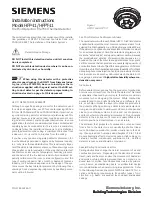64
Operation Manual
FT1020G3 Rev 2.10.4
Note:
The delayed alarm function for a conventional Zone Line Input e.g. 4461 Input 0 (Z)
or zone expansion board 4580 inputs is different. The “Delayed alarm” check box in the
Zone Line Input properties is called “AVF”, the general delayed alarm function will not be
used and will be replaced by the alarm verification function (AVF).
15.7.2
Alarm Delay Facility (ADF)
The ADF is an optional function added in the AS1670.1:2015. The function is similar to the
Alarm Acknowledgement Facility (AAF) without manual acknowledgement button (LAA or
AAM). Instead of the manual control, the function will be automatically control by a time
delay that can be set in the system properties.
In this specific application, the alarm activation type for an output unit e.g. 3379 must be
set (in EBLWin) to “DelayedAlarmZoneAddress” (or zone). In this case, when the alarm
point (only analogue smoke or multi detectors) activates an alarm, the output unit 3379 will
sound for the predetermined time delay period without signalling alarm to the FDCIE. If the
alarm point remains in alarm after the time delay elapsed, a general fire alarm in the FDCIE
will be generated. If the smoke cleared form the smoke detector before the end of the time
delay period, the alarm will automatically reset and the system remains in the normal
condition. The delay for this application can be selected in EBLWin system properties for
up to 255 seconds.
Application Example:
A typical application for the ADF would be a residential accommodation where false alarms
may cause a brigade call. A sounder base(s) 3379 is used as a local warning, it is mounted
inside the apartment and will activate upon receiving an alarm from a smoke detector inside
the unit and continues to operate for the time delay configured in the system properties (0-
255 sec). If the smoke has not been cleared from the smoke detector during the time delay,
the control panel will generate a general fire alarm. If the smoke clears up within the delay
time, the alarm will automatically reset, 3379 will be silenced and the system restores to
the normal condition.
Several control expressions are available to cover any possible configuration:
•
DelayedAlarmZoneAddress (Zone, Address), true when a specific zone / address
is in delayed alarm state.
•
DelayedAlarmZone (Zone), true when a specific zone or any detector in a specific
zone is in delayed alarm state.
•
GeneralDelayedAlarm, true when any zone or zone/address is in delayed alarm
state.
15.8
Local Alarm Acknowledgement (LAA) Facility Control
One or more Local Alarm Acknowledgement Unit (LAAU or discontinued AAM) can be used
in the system.
The LAAF is a function requires wall mounted Local Alarm Acknowledgement Unit (LAAU)
4445 or the Brooks discontinued Alarm Acknowledgement Module (AAM) 3340. The LAAU
is used in residential applications to provide the occupant with a local control facility to
control nuisance alarms within the occupancy e.g. cooking fumes, smoking, aerosol spray,
steams, etc. and prohibit this nuisance alarm from generating a general fire alarm within
the building. It provides the occupant inside the sole occupancy unit with a pre-determined
time to acknowledge a nuisance alarm and additional time to investigate the alarm in the
active unit.
A complete AAF zone requires an LAAU (AAM), one or more sounder base 3379 and up
to 5 analogue smoke detectors (sensors). Each AAF unit configured as an AAF zone.
Summary of Contents for Firetracker FT1020G3 CIE
Page 1: ...Operation Manual FT1020G3 Rev 2 10 4 For Software V2 10 4 FT1020G3 FDCIE MA430 March 2023...
Page 2: ...This page has deliberately been left blank...
Page 176: ...176 Operation Manual FT1020G3 Rev 2 10 4 Figure 24 FT1020G3 Standard Block Wiring Diagram...
Page 177: ...177 Operation Manual FT1020G3 Rev 2 10 4 Figure 25 FT1020G3 New 5012 PCB Layout...




